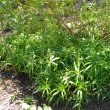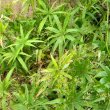| Botanical Name |
|
| Family |
Cyperaceae - The cyperus family. |
| Pronunciation |
sih-PEER-us AL-bo-stree-ah-tus |
| Common Name(s) |
English: Forest star sedge
|
| Plant Group |
- Ground Cover A plant with a low-growing, spreading habit, grown specifically to cover the ground.
|
| Plant Size |
- Medium
| Tree | 10m to 16m |
| Shrub | 1m to 2m |
| Perennial/ground cover | 40cm to 60cm |
| Bulb | 40cm to 60cm |
| Succulent | 40cm to 60cm |
|
| Position |
- Canopy Shade Canopy shade is found below closely grown trees where some light filters through. Ideal for the protection of herbaceous plants.
- Deep / Full Shade Shade below spreading evergreen trees where sun's rays are unable to penetrate the canopy at any time. For light sensitive plants
- Light or Dappled Shade Found below trees with sparse, open foliage. Ideal for the protection of herbaceous plants.
- Partial Shade The area is in shade for part of the day and in full sun for part of the day.
|
| General Information |
- Drought Tolerance: Moderate The plant is moderately adapted to arid conditions and can survive short periods of drought and high temperatures without extra water.
- Evergreen Plants that have leaves all year round.
- Frost: Half-hardy The plant is able to survive low temperatures and some frost but requires protection against severe frost.
- Roots Invasive Do not plant near pools, paving, walls or buildings.
- Water Moderate These plants will need some extra watering compared to water-wise plants. Plant them together, in at least some shade and in a convenient proximity to the house so that grey water can be utilised during times of drought.
- Wind Tolerant Plants able to withstand the effect of strong winds.
|
| Specific Information |
Reportedly this plant can be mowed to form a lawn. I have yet to try it, but it sounds interesting. Flower heads last a long time before becoming untidy. Although water loving, I have found this plant to be useful in shady areas that are quite dry.
|
| Ad Break |
|
| Flowers |
| Description |
fronds of soft grassy heads
|
| Season |
- Summer Plants will seldom bloom for the entire season as given in the list, but should flower during a period within these parameters.
|
| Colour |
|
| Growth Rate |
- Fast Specifying growth rate can be very misleading as there is considerable variation of growth rate depending on type and species of plant, available water, supplementary feeding, mulching and general care, as well as the plants suitability and adaptability to the garden environment.
|
| Plant Uses |
- Attracts Birds This plant will attract birds.
- Container Trees, shrubs and ornamental species that can adapt to growing in a restricted environment.
- Filler Either a fast growing tree or shrub used temporarily to fill in an area while the permanent plants grow to a desired size, or a plant used to fill gaps in borders or beds.
- Foliage Plant Plants grown because their foliage is colorful or unique. Many of these plants have insignificant flowers.
- Ground Cover Low-lying plants that spread fast, require minimal maintenance, and cover large expanses or bare areas between bulbs or shrubs. They provide protection from erosion and drought and improve the visual appearance of the garden.
- Mass Planting Plants useful for filling a large area with just one or a few kinds of plants spaced close together. Creates a bold, dramatic effect and to reduces maintenance.
- Stabilize Banks Plant is used to prevent soil erosion because their roots will form a mat that stabilizes the soil and keeps it from washing away in heavy rains.
- Suitable for coastal gardens Plants adapted to dry, sandy soil, forceful wind, limited rainfall and intense sunlight.
- Water Features These plants may have dramatic, lush foliage or graceful form. They do not shed excessive leaves and do not have invasive root systems.
|
| Distribution and Habitat |
From the Eastern Cape northwards
|
| Planting Suggestions |
Excellent for wet areas, ponds and water gardens. Plant in shade in a moist position or in an area that gets some extra water. If the soil is very sandy, use plenty of compost and mulch to increase the water retention of the soil. A feeding of high nitrogen fertilizer will result in a darker leaf colour. Use carefully in small gardens as it grows vigorously. When flower heads begin to look tired, use shears to cut the plants quite low down, ensuring a healthy, green growth for the following year.
|
| Medicinal Uses |
|
| Ad Break |
|







Discuss this plant
Share knowledge, ask a question or give an experience.